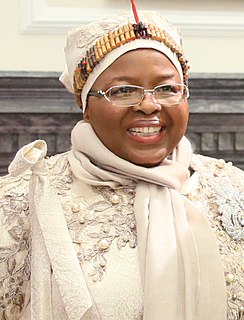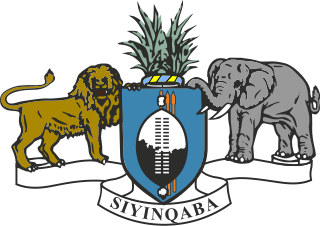| |||||
| Decades: | |||||
|---|---|---|---|---|---|
| See also: | |||||
The following lists events that happened during 1978 in Eswatini .
| |||||
| Decades: | |||||
|---|---|---|---|---|---|
| See also: | |||||
The following lists events that happened during 1978 in Eswatini .

Eswatini, officially the Kingdom of Eswatini and formerly named Swaziland, is a landlocked country in Southern Africa. It is bordered by Mozambique to its northeast and South Africa to its north, west, south, and southeast. At no more than 200 kilometres (120 mi) north to south and 130 kilometres (81 mi) east to west, Eswatini is one of the smallest countries in Africa; despite this, its climate and topography are diverse, ranging from a cool and mountainous highveld to a hot and dry lowveld.

Artifacts indicating human activity dating back to the early Stone Age have been found in the Kingdom of Eswatini. The earliest known inhabitants of the region were Khoisan hunter-gatherers. Later, the population became predominantly Nguni during and after the great Bantu migrations. People speaking languages ancestral to the current Sotho and Nguni languages began settling no later than the 11th century. The country now derives its name from a later king named Mswati II. Mswati II was the greatest of the fighting kings of Eswatini, and he greatly extended the area of the country to twice its current size. The people of Eswatini largely belong to a number of clans that can be categorized as Emakhandzambili, Bemdzabu, and Emafikamuva, depending on when and how they settled in Eswatini.

Mswati III is the king of Eswatini and head of the Swazi royal family. He was born in Manzini in the Protectorate of Swaziland to King Sobhuza II and one of his younger wives, Ntfombi Tfwala. He was crowned as Mswati III, Ingwenyama and King of Swaziland, on 25 April 1986 at the age of 18, thus becoming the youngest ruling monarch in the world at that time. Together with his mother, Ntfombi Tfwala, now Queen Mother (Ndlovukati), he rules the country as an absolute monarch. Mswati III is known for his practice of polygamy and currently has 15 wives.
Absalom Themba Dlamini was the Prime Minister of Eswatini from November 2003 to September 2008. He is the managing director of Tibiyo Taka Ngwane.

The flag of Eswatini was adopted on October 6, 1968 after Eswatini gained independence from the British Empire one month before. The design by King Sobhuza II features a black and white shield, with a staff and two spears, on a field of blue, yellow, and red horizontal bands.

The Swazi or Swati are a Bantu ethnic group in Southern Africa, inhabiting Eswatini, a sovereign kingdom in Southern Africa. EmaSwati are part of the Nguni-language speaking peoples whose origins can be traced through archaeology to East Africa where similar traditions, beliefs and cultural practices are found.

Sobhuza II, was the Paramount Chief and later Ngwenyama of Swaziland for 82 years and 254 days, the longest verifiable reign of any monarch in recorded history. Sobhuza was born on 22 July 1899 at Zombodze Royal Residence, the son of Inkhosikati Lomawa Ndwandwe and King Ngwane V. When he was only four months old, his father died suddenly while dancing incwala. Sobhuza was chosen king soon after that and his grandmother Labotsibeni and his uncle Prince Malunge led the Swazi nation until his maturity in 1921. Sobhuza led Swaziland through independence until his death in 1982. He was succeeded by Mswati III, his young son with Inkhosikati Ntfombi Tfwala, who was crowned in 1986.
Mswati II, also known as Mswati and Mavuso III, was the king of Eswatini between 1840 and 1865. He was also the eponym of Eswatini. Mswati is considered to be one of the greatest fighting kings of Eswatini. Under his kingship, the territorial boundaries of Eswatini were greatly increased. Mswati was the son of Sobhuza I and Tsandzile Ndwandwe who after ruling as Queen Mother became Queen Regent after the death of her son. After the death of Sobhuza, Mswati inherited an area which extended as far as present day Barberton in the north and included the Nomahasha district in the Portuguese territory of Mozambique. Mswati's military power, initially suppressed by infighting with his brothers Fokoti, Somcuba and Malambule, was increased in the late 1850s and thereafter. When Mswati's armies attacked organized forces of other Bantu tribes or nations, the goal was initially plunder in the form of cattle and captives, rather than incorporation into one political unit. During this period the arrival of Trekboers, in what would become the Transvaal republic, marked the first contact between Swazis and European settlers. Mswati greatly extended the boundaries of the Swazi territory beyond that of the present state with military outposts and royal villages outposts such as Mbhuleni, on the upper Komati River at the foot of the Mkongomo Mountains, south of Badplaas, Mekemeke which is east of the Mbayiyane Mountains, situated east of Mantibovu. The death of Mswati II in August 1865 ended the era of Swazi conquest, territorial expansion and resulted in unification of various people into one nation.

Queen Ntfombi, The Queen Mother, Ndlovukati of Eswatini is the current Ndlovukati and joint head of state of Eswatini, serving since 1986. She was also regent of Eswatini from 1983 to 1986. She is the mother of King Mswati III.

Ndlovukati is the Siswati title for the female monarch of Eswatini. The title is given preferentially to the mother of the reigning king, or to another female royal of high status if the king's mother has died. The title is roughly equivalent to a queen mother, though she is jointly head of state, ruling alongside the Ngwenyama. When there is no king, the Ndlovukati rules as queen regent. The current Ndlovukati is Queen Ntombi Tfwala, the mother of Ngwenyama Mswati III and wife of Sobhuza II. She was also queen regent from 1983 until 1986 when Mswati became king. The most notable queen regent was Ndlovukati Labotsibeni Mdluli who ruled Swaziland from 1899 until 1921 when she abdicated for Sobhuza II.
Sobhuza I was king of Eswatini, from 1815 to 1836. Born around 1780, his father was Ndvungunye, and his mother was Somnjalose Simelane. He was called Somhlolo, "the Wonder," upon his birth because his father, Ndvungunye, was struck by lightning. When Sobhuza was king, Lojiba Simelane instead of his mother Somnjalose was Queen Mother because Somnjalose was an inhlanti or support bride to Lojiba. Somhlolo is a greatly revered king of Eswatini. He had his first royal capital or kraal at Zombodze in the Shiselweni region, but moved it north to new Zombodze in central Eswatini. Swazis celebrate Somhlolo Day every September 6 as their Independence Day and the national stadium is named Somhlolo stadium. Sobhuza was succeeded by his son Mswati II and his wife Tsandzile Ndwandwe as Queen Mother after a short regency by Queen Lojiba Simelane. Sobhuza by the time of his death had conquered a country claimed to reach to modern day Barberton in the north, Carolina in the west, Pongola River in the south and Lubombo Mountains in the east.
Lobamba is a city in Eswatini, and is one of the two capitals, serving as the legislative, traditional, spiritual, seat of government of the Parliament of Eswatini, and Ludzidzini Royal Village, the residence of Queen Ntfombi, the Queen Mother.

Tibiyo Taka Ngwane, meaning wealth of the nation, is a Swazi sovereign wealth fund which was created through royal charter under the reign of King Sobhuza II in 1968. The company is currently held by King Mswati III in trust for the Swazi nation and is separate from the government.

In Eswatini, an inkhundla is an administrative subdivision smaller than a district but larger than an umphakatsi. There are 55 tinkhundla in Eswatini: 14 in Hhohho District, 11 in Lubombo District, 16 in Manzini District, and 14 in Shishelweni District. According to the constitution of Eswatini, the government for Eswatini is a democratic, participatory, tinkhundla-based system that emphasizes devolution of state power from central government to tinkhundla areas and individual merit as a basis for election or appointment to public office. The system is non-partisan since the constitution does not recognize political parties, although section 25 of the constitution allows for open freedom of assembly and association. Each inkhundla elects one representative to the House of Assembly of Eswatini, the lower chamber of the bicameral parliament (Libandla). The same trend is applied in local government elections. This governing system was designed by King Sobhuza II with the assistance of political scholars and lawyers. It came to effect in 1978 and was adjusted in the early 1990s.

Eswatini–Russia relations are the bilateral relations between the nations of Eswatini and Russia.
Lojiba Simelane was the queen regent and Indlovukati of Swaziland from 1836 after the death of Sobhuza I until 1840 when King Mswati II became the king.
Law enforcement in Eswatini is the primarily the responsibility of the Royal Eswatini Police Service, which oversees internal security as well as border and customs control, and His Majesty's Correctional Services (HMCS), which is tasked with maintaining and guarding prisons. It is estimated that about 35% of Government of Eswatini employees work in the security services. The country has been part of INTERPOL since October 1975 and the organization has an office in the capital of Eswatini, Mbabane.

The 2005 constitution is currently in force. The constitution of 6 September 1968 was suspended 12 April 1973 by a State of Emergency decree imposed by King Sobhuza II, the father of the current King Mswati III. The decree gave absolute power to the monarchy and banned organised political opposition to royal rule.
Eswatini remained a British protectorate throughout World War II. As such, it fought alongside the Allies against the Axis. While no large scale battles or major military operations took place in or around Eswatini, the colony did supply the Allies with troops during the war. World War II was also responsible for several important domestic developments in Eswatini.